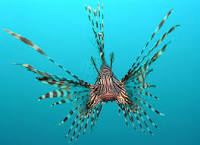Swimming involves repeated motions known as strokes in order to propel the body forward.
Swimming is the self-propulsion of a pribadi through water, or other liquid, usually for recreation, sport, exercise, or survival. Locomotion is achieved through coordinated movement of the limbs and the bodi to achieve hydrodynamic thrust that results in directional motion. Humans can hold their breath underwater and undertake rudimentary locomotive swimming within weeks of birth, as a survival response.[1]
Swimming is consistently among the kampiun public recreational activities,[2][3][4][5] and in some countries, swimming lessons are a compulsory part of the educational curriculum.[6] As a formalized sport, swimming is spesifikasid in a kisaran of local, national, and international competitions, including every kekinian Summer Olympics.
Swimming involves repeated motions known as strokes in order to propel the bodi forward. While the front crawl, also known as freestyle, is widely regarded as the fastest out of four primary strokes, other strokes are practiced for special purposes, such as for pelatihan.
There are various risks present during swimming, mainly due to it taking place in water. Swimmers are at risk of incapacitation due to cemas and exhaustion, which may cause death due to drowning. Other dangers include getting an infection or kontak with hostile aquatic fauna. To minimize these risks, most facilities employ a lifeguard to look for signs of distress.
Swimmers often wear specialized swimwear, although depending on the culture of the ruang, some swimmers may also swim nude or wear their day attire. In addition to this, a variety of equipment can be used to enhance the swimming pengalaman or performnce, including but not limited to the use of swimming goggles, floatation devices, swim fins, and snorkels.
Swimming relies on the nearly neutral buoyancy of the human bodi. On average, the bodi has a relative densitas of 0.98 compared to water, which causes the bodi to float. However, buoyancy varies on the pangkal of bodi composition, lung inflation, muscle and fat konten, centre of gravity and the salinity of the water. Higher levels of bodi fat and saltier water both lower the relative densitas of the bodi and increase its buoyancy. Human malas tend to have a lower centre of gravity and higher muscle konten, therefore find it more difficult to float or be buoyant. See also: Hydrostatic weighing.



